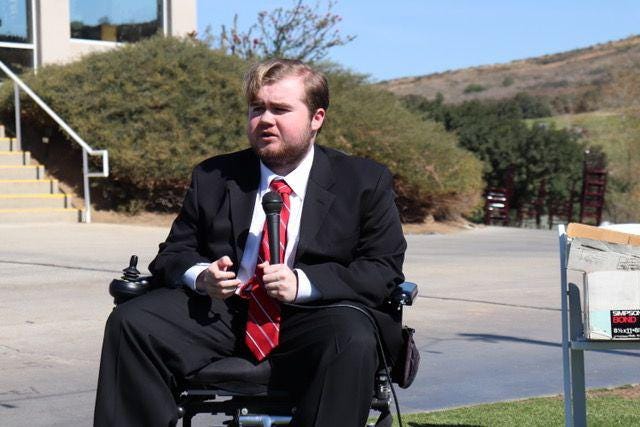
Elijah Stacy, who suffers from Duchenne, a genetic disorder characterized by the progressive loss of … [+]
It isn’t all that often when I personally meet someone that leaves me speechless. But I had that reaction, particularly at this time for reflection and giving, when I met a young man named Elijah Stacy, 20, who published a book in September called A Small If. Then I reminded myself of the power of the media landscape and how it can shed tremendous light on any individual and/or on any given cause.
Elijah Stacy is one such individual. Duchenne muscular dystrophy is his cause. And his mission, in his words, is “to minimize human suffering and propel human prosperity” in the quest to find a cure for this disease.
Elijah suffers from Duchenne, a genetic disorder characterized by the progressive loss of muscle. By definition, Duchenne musical dystrophy is a multi-systemic condition, affecting many parts of the body, which results in deterioration of the skeletal, heart, and lung muscles. He was diagnosed with the disease at age six, and it has also impacted the lives of his two younger brothers: Max, who died in January 2019, and Kai, now 14. Yet, after speaking with Elijah, his eternally optimistic tone only magnifies his goal to save lives and find a cure for Duchenne.
“This disease, of course, is a large part of my life,” said Elijah on a Zoom call. “But I don’t consider myself a disabled person. Instead, I am someone with a disability, and that in itself is a huge difference.”
As the founder of the non-profit Destroy Duchene at age 15, Elijah is determined to advance gene editing and gene therapy to find a cure for Duchene. His vision: a world where those afflicted by diseases will be cured and their health restored back to normal.
MORE FOR YOU
“Everyone is going to face adversity at some point in their lives, but what you do about it instead of being swallowed in self defeat is how you deal with it,” noted Elijah, who in his book A Small If offers the 13 lessons he has learned by dealing with Duchene. Included are defeating the odds; staying ambitious; being self-sacrificing; remaining consistent; adapting to unexpected challenges; being a leader to someone; and practicing the combination of appreciation, thankfulness and gratitude in everyday life in any circumstance.
In his book “A Small If”, Elijah Stacy offers the 13 lessons he has learned by dealing with Duchene … [+]
“The whole story of my life has literally been people telling me you can’t be this or you can’t be that, and I go and do it,” he said. “I get so much motivation when people put obstacles in my way and I prove just the opposite. A Small If is literally the story of my doctor telling me I needed spinal surgery and how I successfully chose physical therapy as another option.”
“No matter how many obstacles are thrown in my direction, or in others that suffer from Duchenne (or any disease), it is important to remain focused. It is not what I can’t do; it is what I can do. Keep the faith, focus on the good and, eventually, it will all come together.”
The Power of Media
Late actor and comedian Jerry Lewis, of course, immediately comes to mind in the fight for a cure for Duchene Muscular Dystrophy or any form of the disease. Way before the advent of social media, his annual MDA telethon became an American tradition each Labor Day weekend for 45 years, raising awareness and funding in a fight for a cure. But you don’t have to be a celebrity to preach your cause and educate the audience.
For example, at a time when the then rapidly advancing AIDs epidemic was largely stigmatized as an illness impacting the gay community only, a teenager named Ryan White, then just 13, became infected with HIV from a contaminated blood treatment. Given just six months to live, Ryan was chastised after returning to school, which made the headlines and turned him into the national poster child for HIV/AIDS.
Ryan, like Elijah Stacy at present, began making the rounds with public speaking appearances, fundraisers, and as a guest on numerous talk shows to educate the public about his illness. His story was documented by ABC in the 1989 television movie The Ryan White Story, which shed more light on this subject matter. And a rising number of celebrities and national personalities, including then President Ronald Reagan and First Lady Nancy Reagan, befriended him.
Shortly after Ryan’s death on April 8, 1990, the U.S. Congress passed a major piece of AIDS legislation, the Ryan White CARE Act. Ultimately, Ryan lived more than five years longer than initially predicted, and the impact he had through the media educating society about his illness was monumental.
In 1993, three years after Ryan’s passing, Tom Hanks’ Academy Award-winning role as a senior associate at a law firm in theatrical Philadelphia became one of the first mainstream Hollywood films to acknowledge HIV/AIDs.
Then there is Brooke Ellison, who was struck by a car when she was 11, paralyzing her from the neck down. Brooke, like Elijah Stacy, documented her story. She was the co-author of the 2002 bestseller, One Mother, One Daughter, One Journey. Then, in 2004, she was the subject of the TV movie The Brooke Ellison Story, directed by Christopher Reeve, who was also a quadriplegic, and starring Lacey Chabert (Party of Five) as Brooke.
Additionally, in 2005, Ellison teamed up with director James Siegel to create the documentary Hope Deferred, which aims to educate the general public about embryonic stem cell research.
Countless other individuals challenged with various diseases have also used media to inform, to educate, and to hopefully find a cure.
David Faigenbaum, for example, made the media rounds with his book, Chasing My Cure: A Doctor’s Race to Turn Hope Into Action, in his personal quest to find a cure for idiopathic multicentric Castleman (iMCD) disease. His motto: “I got out of the hospital with this profound sense of you need to make the most of every second.” And, in 2020, at the age of 16, Helen Obando was branded a pioneer in her fight to cure sickle cell anemia, to name a few.
Elijah Stacy’s Mission
“I started to get the community’s attention in my high school using my marketing knowledge in an initiative I called the DMD Ice Cup Challenge,” noted Elijah. “The cup is smaller than the bucket in the ALS Ice Bucket Challenge, which symbolizes that this disease also impacts kids. People were actually doing it across the globe.”
“Earlier, I started doing public appearances when I was 16,” he said. “Then the media started kicking off when I wrote the book. And while A Small If talks in detail about Duchenne, it is also about overcoming any adversity. Through my story, I want to inspire people. I want to motivate people. And I want to help them overcome their suffering and live a more fulfilling life. The more appearances I make, the more this will bring attention to Duchenne.”
Like Ryan White and Brooke Ellison, and others, the power of the media landscape – on air, in print and now on social media – gives Elijah Stacy the platform to fulfill his quest.
“Thanks to the Make-A-Wish Foundation, I got the chance to meet Elijah Stacy and his family,” wrote Amazon founder and executive chairman Jeff Bezos on Instagram. “Elijah has a type of muscular dystrophy called Duchenne, and he’s been working to help find a cure. Elijah’s optimistic nature is one of his standout characteristics, and it’s inspiring.”
“The story of a warrior is the best way to describe the life of Elijah Stacy,” wrote a reader on Amazon in a review of A Small If. “Fighting till the end even when the odds are against you is the warrior mindset that wins wars and, in his case, his battle with Duchenne.”







